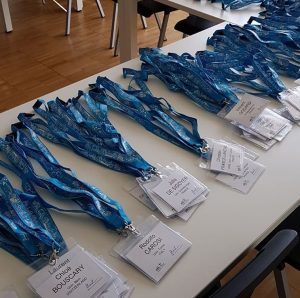The whole group is contributing to the 16th Swiss Geoscience Meeting in Bern, with one poster per person, in sessions 1, 7 an 16. Check the meeting program here.
The crustal structure study in Western Nepal is accepted
The first paper on crustal structure in western Nepal, a study from our group, is recently accepted for publication in Geophysical Research Letters (GRL). The Moho and the Main Himalayan Thrust (MHT) is investigated using the receiver function technique. It should be an important finding as the Moho and the MHT is poorly known in the area. Now, it has a DOI and can be officially cited.
Subedi S, Hetényi G, Vergne J, Bollinger L, Lyon-Caen H, Farra V, Adhikari LB, Gupta R (2018), Geophysical Research Letters. doi:10.1029/2018GL080911
Second Raspberry Shake in Nepali schools
Early November has seen Shiba Subedi successfully installing the second Raspberry Shake seismometer in the Nepali school seismology network. The station is online, and the records can be seen here. The first ever RS station in Nepal is functioning well (records are here).
Stress, GPE and Tibet
Magnitudes of differential stress in the lithosphere, especially in the crust, are still disputed. Our recent work addressing this topic with numerical modelling and geophysical data from the field has just been accepted at Geophysical Journal International:
Schmalholz SM, Duretz T, Hetényi G, Medvedev S (2019) Distribution and magnitude of stress due to lateral variation of gravitational potential energy between Indian lowland and Tibetan plateau. (weblink)
HKT2018 videos: Peter Molnar’s invited talk
Thanks to a dedicated team lead by Simon Hiscox, there are three videos available from the recent HKT2018 conference. The highlight is the invited talk of Peter Molnar about The Growth of the Tibetan Plateau, now online in full length and resolution, both here below and on YouTube.
Post-HKT and Tibet low-velocity zones
The 33rd HKT conference is over and we keep a great memory of this event! A final, post-conference message is yet to come, with the group photo, the keynote speech’s video, etc.
Following the advice of one of the participants and a good colleague, I here share the PDF version of a 7-year old article that is not so visible, showing that seismic low-velocity zones in South Tibet are present in spots, and do not form a continuous layer.
The HKT2018 conference is coming up
After more than a year preparation, the 33rd Himalaya-Karakorum-Tibet workshop is at the doorstep. From Monday to Wednesday next week (Sept. 10-12) more than 130 researchers will present ca. 45 talks and ca. 85 posters on the structure, dynamics and natural hazards of the HKT region. The invited keynote speaker is Peter Molnar (U. Colorado), who will talk about the Growth of the Tibetan Plateau. About 35 people will also go on a 3-day field excursion in the Western Swiss Alps before the workshop. Full information can be found at the HKT2018 website. We look forward to host the event and the participants.

Seven years in Bhutan
Are earthquakes and faults close to each other in Switzerland?
General knowledge of geoscientists holds that earthquakes occur on faults, and faults are created by brittle failure. But how good is the spatial correlation between the two datasets? This is the question we have analyzed from various sides in our freshly published paper.
Bhutan Himalaya – Shillong Plateau seismotectonics paper
Our work on the seismotectonic interaction between the Bhutan Himalaya and the Shillong Plateau has just been published in Tectonophysics. The results point to a weaker interaction between thrust faults in the two regions than previously suggested. Earthquakes on these thrusts mostly affect strike-slip faults connecting the two regions, so there is no “stress shadow” effect from the 1897 earthquake on the Bhutan Himalaya.
